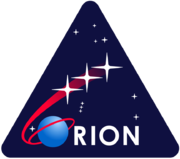Exploration Mission 2
| Mission type | Manned Lunar Flyby |
|---|---|
| Operator | NASA |
| Spacecraft properties | |
| Spacecraft type | Orion MPCV |
| Start of mission | |
| Launch date | August 2021 (planned) |
| Rocket | SLS Block 1B |
| Launch site | Kennedy LC-39B |
| End of mission | |
| Landing site | Pacific Ocean |
|
Orion Program
|
|
The Exploration Mission 2 or EM-2 is scheduled to be the first crewed mission of NASA's Orion on the Space Launch System. The mission is to restart manned exploration of the Solar System. NASA is aiming to launch between 2021 and 2023, with a crew to perform a practice flyby of a captured asteroid in lunar orbit. Unless Russia's touristic DSE-Alpha or SpaceX flies two passengers around the Moon (both currently planned for 2018), this mission will be the first to send humans beyond low Earth orbit since Apollo 17 in December 1972.
EM-2 is a single-launch mission of a Space Launch System Block IB with an Exploration Upper Stage, lunar Block 1 Orion Multi-Purpose Crew Vehicle (MPCV), and a payload insertion of 50.7 t. It is to be an eight-day mission with a crew of four astronauts, sent on a free return trajectory around the Moon.
Apollo 8 was a similar mission in 1968, in that it was crewed, and did not land on the Moon; crewed by 3 astronauts, designed to flight test a Command Service Module beyond low Earth orbit. It however did enter lunar orbit, for an extended stay.
A proposed late 2018 SpaceX lunar tourism mission is similar to EM1, with two space tourists paying for a free-return loop around the Moon and back to Earth, using the Crew Dragon capsule and launched on the Falcon Heavy. At the time of announcement in early 2017, neither this version of the Dragon nor Falcon had yet flown.
...
Wikipedia

